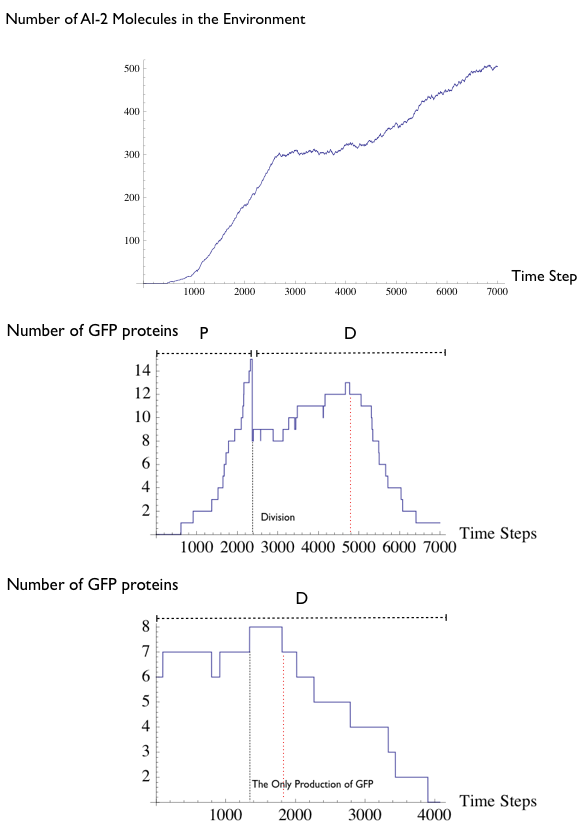From 2009.igem.org
(Difference between revisions)
|
|
| Line 164: |
Line 164: |
| | <br> | | <br> |
| | <div class="heading"> | | <div class="heading"> |
| - | Descriptive Title of What You're Doing
| + | Construction Verification: Restriction Digest and Colony PCR, Team Meeting |
| | </div> | | </div> |
| | <br> | | <br> |
| | <div class="desc"> | | <div class="desc"> |
| | </html> | | </html> |
| - | WIKI CODING HERE
| + | *Today I isolated plasmid from my overnight cultures of R0040-I13500. I proceeded with a verification digest of all three of my constructions (B0034-LuxOD47E, B0034-K082003 and ROO40-I13500) as well as a colony PCR of all three of my constructs. Of these, only B0034-LuxOD47E looked proising, so we will be sending colony 2 down for sequencing on Monday. |
| | + | |
| | + | *This evening we had a team meeting where we discussed the status of Reporter/Mutant testing, modelling and our High School Outreach presentations. We also discussed T-Shirt designs. |
| | | | |
| | <html> | | <html> |
Latest revision as of 23:32, 21 October 2009
University of Calgary

|
|
CAROL
Descriptive Title of What You’re Doing
WIKI CODING HERE
|
|
|
CHINMOYEE
Descriptive Title of What You're Doing
|
|
|
EMILY
Construction Verification: Restriction Digest and Colony PCR, Team Meeting
- Today I isolated plasmid from my overnight cultures of R0040-I13500. I proceeded with a verification digest of all three of my constructions (B0034-LuxOD47E, B0034-K082003 and ROO40-I13500) as well as a colony PCR of all three of my constructs. Of these, only B0034-LuxOD47E looked proising, so we will be sending colony 2 down for sequencing on Monday.
- This evening we had a team meeting where we discussed the status of Reporter/Mutant testing, modelling and our High School Outreach presentations. We also discussed T-Shirt designs.
|
|
|
FAHD
Descriptive Title of What You're Doing
|
|
|
IMAN
Modeling Paper:
This paper is being done very soon,as we are working on its concepts to obtain nice results, and to interpret them. I just share some of the new results discussed in this paper here:
As we all know, bacterial cell division is the process by which a bacterial cell creates two genetically identi-
cal daughter cells. It takes approximately 20 minutes for a newborn bacterial cell to reach to the
next division stage in a proper environmental condition. Within this 20 minutes, parental genetic
materials and its essential components and organelles are duplicated and distributed between the
two daughter cells. However the chemicals available within the parent cell are not duplicated,
whereas they are equally distributed between two daughter cells. One of the characteristics of
bacterial populations is that they increase in size exponentially in optimum environment. How-
ever, toxic waste products and competition for food and nutrients reduce the speed of population
growth and stabilize the number of bacteria in the population. Having this function implemented will help us to observe more realistic emergent properties in the system:

This figure demonstrates the comparison of production and degradation of GFP proteins in parent cells and newborn cells. The First graph
shows that the number of AI-2 molecules in the environment is continuously increasing over the 7000 steps. The second
graph shows the number of GFP proteins within one of the parent cells (indicated by ”P”) in the simulation. This cell
keeps producing GFP proteins up to the division point. After that the newborn daughter cell (indicated by ”D”) continues
the production of GFPs, however it does not last very long as this cell reaches to the point (indicated by red line) that
recognizes the high concentration of AI-2 in the environment and cancel the production of GFPs. After this point, the
degradations of GFPs occur. Graph 3 demonstrates the number of GFP proteins in one of the newborn cells in the
simulation and implies that the production of GFP proteins occurs once (indicated by black line) in this cell. However
after very soon the cell changes its biological cascade and hence the inherited GFP proteins and the produced one are
degraded. The reason for observing this behavior is since the concentration of AI-2 molecules in the environment is high
by the birth time of daughter cells, they switches to the second biological cascade faster than their parent cells that keep
producing GFPs for more than 2000 time steps.
|
|
|
JAMIE
Descriptive Title of What You're Doing
|
|
|
JEREMY
Descriptive Title of What You're Doing
|
|
|
KATIE
Descriptive Title of What You're Doing
|
|
|
KEVIN
Descriptive of What You're Doing
|
|
|
MANDY, STEFAN & PRIMA
Mascot Time!
Today we went to Michaels to pick up coloured foam, velcro and other crafts in order to make a mascot. Once we got the required materials, cutting and gluing started. Luckily, we already have a green suit (don't ask how). Shapes were cut into terminators, promoters and other parts and stuck them to the suit to create our circuit. Since it is with velcro, the phosphorylation cascade was also constructed and interactive!
|
|
|
PATRICK
Descriptive Title of What You're Doing
|
|
|

 "
"











